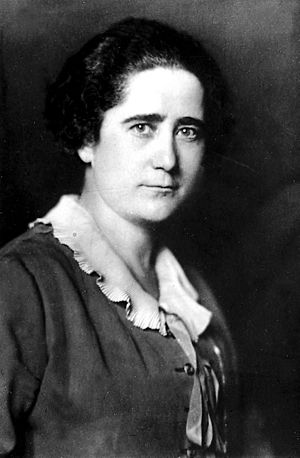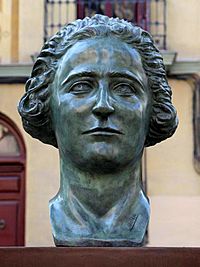Clara Campoamor facts for kids
Quick facts for kids
Clara Campoamor
|
|
|---|---|

Campoamor in 1930
|
|
| Born |
Clara Campoamor Rodríguez
12 February 1888 Madrid, Spain
|
| Died | 30 April 1972 (aged 84) Lausanne, Switzerland
|
| Nationality | Spanish |
| Alma mater | University of Madrid |
| Occupation |
|
| Years active | 1929 – 1972 |
| Known for |
|
Clara Campoamor Rodríguez (born February 12, 1888 – died April 30, 1972) was an important Spanish politician, lawyer, and writer. Many people see her as a key figure in the fight for women's rights in Spain. She worked hard to get women the right to vote, and her efforts helped make this happen in the Spanish Constitution of 1931.
She was chosen for the Constituent Assembly in 1931. This was before women in Spain were even allowed to vote themselves! Later, she lost her spot in parliament and briefly worked as a government minister. She then had to leave the country during the Spanish Civil War for her safety. Clara Campoamor passed away while living in Switzerland. Her remains were later brought back to Spain and buried in the Polloe Cemetery in San Sebastián.
Contents
Clara Campoamor's Life Story
Clara Campoamor Rodríguez was born on February 12, 1888, in Madrid, Spain. Her family was working-class. She started working as a seamstress when she was just 13 years old. Even with work, she kept studying part-time. She wanted to pass a special test to get into law school.
Before law school, she worked in different government jobs. First, she worked for the Post Office in San Sebastián in 1909. Then, she became a typing teacher in Madrid in 1914. Besides teaching, Clara also became a journalist for a newspaper called La Tribuna. This job helped her meet important women of her time, like Carmen de Burgos. These connections led Clara Campoamor to join and work with different groups that supported women's rights. She also wrote articles about politics.
After passing her law school entrance exam, Clara went to the University of Madrid School of Law. She still worked many jobs while studying. She was a teacher, a newspaper secretary, a government typist, and a French translator. In 1924, at 36 years old, she earned her law degree. She then started working as a lawyer.
Clara Campoamor became the second woman ever to join the Madrid Bar Association. She was also the first woman to argue a case in Spain's highest court. She was one of the first to represent Spain in the League of Nations. Her law practice focused on issues important to women. This included cases about who a child's father was and marriage laws. She fought for these issues in professional groups she joined. She also helped start the International Federation of Women Lawyers in 1928. In 1927, Campoamor successfully pushed for better child labor laws and changes to election rules.
In 1931, women were allowed to run for the Constituent Assembly. This assembly would write a new constitution for Spain. Clara ran for a seat and was elected, even though she couldn't vote herself!
In October of that same year, she became the first woman to speak to the assembly. She gave a powerful speech. She told the male members that not letting women vote was wrong. She said, "To all deputies: I am a citizen before I am a woman." She warned them that women would be a new power for Spain's laws. Campoamor strongly believed that a new Republic could not be built without half of the country's citizens. Because of this, women needed the right to vote.
Her fight for women's rights was not easy. Some conservative groups and even some men on the left opposed her. One of the two other women in the assembly, Victoria Kent, also disagreed. Kent thought women would be too influenced by Catholic priests. When Clara's own political party decided to oppose women's right to vote, she left the party. She continued to fight for voting rights as an independent member. She kept her independent stance even though political parties were very strong then. With support from women's activists across Spain, she helped make women legally equal in the new constitution. Throughout her political career, Campoamor always said her main job was to speak up for women. Women's issues were always her top concern.
After the new constitution was written, Clara Campoamor became less popular in politics. This was because she spoke her mind and left her party for her beliefs. She lost her seat in parliament in 1933. However, she was appointed Director of Public Welfare from 1933 to 1934. In 1936, the Spanish Civil War began. As fighting started in Madrid, she had to leave the country for her safety.
She lived in Buenos Aires for ten years, working as a translator and writer. Finally, she settled in Lausanne, Switzerland, and worked as a lawyer. She could never return to Spain. This was because she was not allowed back unless she shared names of her allies and apologized for past statements against the Catholic Church. She was even told she would go to prison for 12 years if she returned. As an exile, she kept writing about women's rights and her political experiences.
Clara Campoamor passed away in Switzerland in 1972. Her ashes were brought back to Spain and buried in the Polloe Cemetery in San Sebastián in May 1972.
The Fight for Women's Right to Vote
After the start of the Second Spanish Republic, Campoamor was elected as a representative for Madrid in the 1931 elections. At that time, women could be elected to office, but they could not vote themselves. She joined the Radical Republican Party because it was "republican, liberal, secular and democratic." This matched her own political ideas. She was part of the Constitutional Commission. This group had 21 representatives and was in charge of writing the new Spanish Constitution of 1931.
In this group, she fought hard against unfair treatment based on gender. She also pushed for children born inside or outside marriage to have equal legal rights. She supported the right to divorce and universal suffrage, which is often called the "women's vote." This was a fight to make the Spanish Republic more fair and equal. After much effort and her famous speech, women's right to vote was approved on October 1, 1931. It passed with 161 votes in favor and 121 votes against.
Women getting the right to vote also helped them play a bigger role in political life. It allowed them to be active participants, not just observers. The first election where women could vote in Spain was in 1933. Just three years later, in 1936, Federica Montseny became the first female minister in Western Europe.
Even though Campoamor is called the mother of the feminist movement in Spain, Spanish women had been inspired by suffragettes in the UK and US in the 1920s. The National Association of Spanish Women was created in 1918. The first women's rights demonstration in Spain happened in 1921. Carmen de Burgos, an important figure from this association, became friends with Campoamor when Clara was a teacher. Even before these movements, there was an attempt to get women the right to vote in 1907.
Many on the Left, except for some Socialists and Republicans, did not want women to vote. They thought women would be too influenced by the Church and would vote for conservative parties. So, the Radical Socialist Republican Party put Clara against another well-known representative, Victoria Kent. Kent was actually against women getting the right to vote. The final debate was on October 1. Campoamor was seen as the winner. As a result, Article 36, which gave women the right to vote, was approved. She was supported by most members of the Spanish Socialist Workers' Party, many from the right, and almost all members of Republican Left of Catalonia.
Neither Clara nor Victoria Kent won their seats again in the 1933 elections. In 1934, Campoamor left the Radical Party. This was because the party was too controlled by another group and because of how harshly they stopped a rebellion in Asturias. That same year, she tried to join the Republican Left, but they did not let her in. It was then that she wrote and published her book, Mi pecado mortal. El voto femenino y yo (My Mortal Sin. The Female Vote and I). This book shared her experiences in parliament.
Clara Campoamor's Legacy

After Spain became a democracy again, many groups that support women's equality honored Clara Campoamor. Many schools, cultural centers, women's associations, parks, and streets were renamed after her. In 1998, the Ministry of Equality in Andalusia started the Clara Campoamor Awards. These awards are given every year to people or groups who have been important in fighting for women's equality.
For a long time, Clara Campoamor was not widely remembered. However, her very important role in Spanish politics and her fight for women's rights have been celebrated more recently. For example, the 90th anniversary of women getting the right to vote in Spain was celebrated in Congress. She dedicated her life to standing up for women's rights. While in Argentina, she wrote biographies of other important women. She also wrote articles for many newspapers in Buenos Aires.
In 2006, Madrid City Hall created an award in her name. The first person to receive it was lawyer and feminist María Telo Núñez.
Also in 2006, after the 75th anniversary of women's right to vote in Spain, there was a campaign. It asked for the Congress of Deputies to honor her with a statue in its building. In November, the Socialist Party suggested that Clara Campoamor should appear on future euro coins. This was because she was a leading supporter of women's right to vote. This idea was approved on June 12, 2007, by the Congress. All political groups supported it except for the Conservative Party, which did not vote.
In 2007, the Ministry of Development launched a ship named "Clara Campoamor" in her honor. It is operated by the Maritime Safety and Rescue Society.
In 2011, for the 100th anniversary of International Women's Day, the National Mint and Stamp made a special silver coin worth 20 euros. This coin shows a picture of Clara Campoamor.
In 2016, Norwegian Airlines named one of its new Boeing 737-800 planes "Clara Campoamor." Her photo is on both sides of the plane's tail.
On December 23, 2020, the Madrid Chamartín railway station was officially renamed Madrid-Chamartín-Clara Campoamor.
Depictions
| Title | Year | Director |
|---|---|---|
| Clara Campoamor, la mujer olvidada | 2011 | Laura Mañá |
See also
 In Spanish: Clara Campoamor para niños
In Spanish: Clara Campoamor para niños

